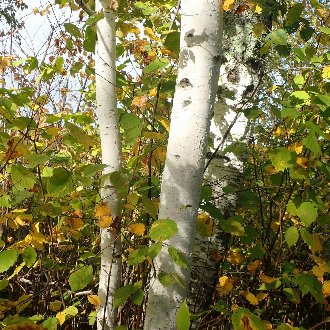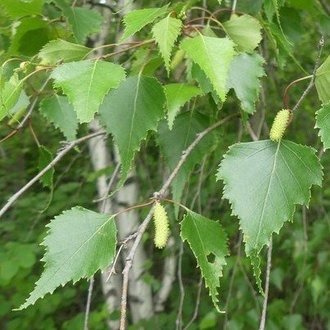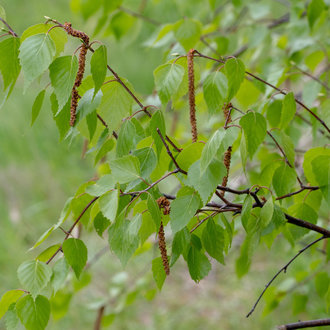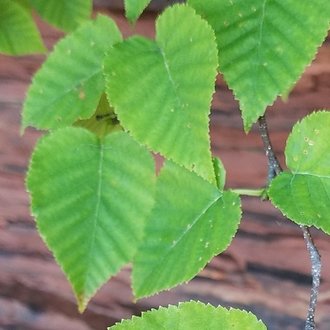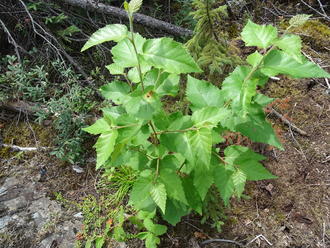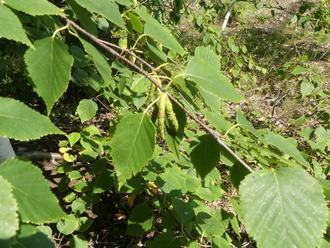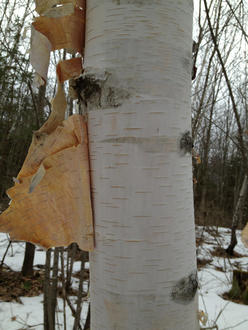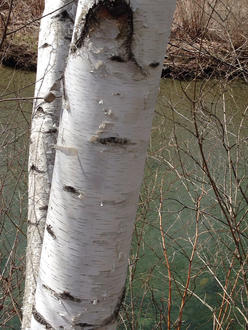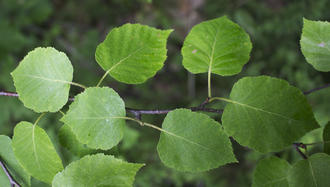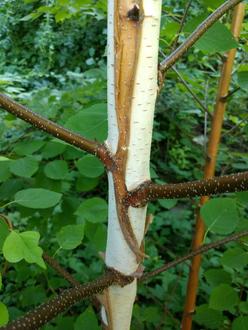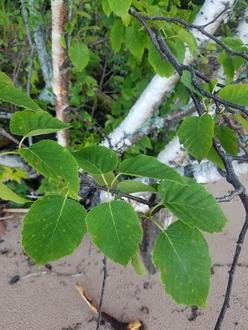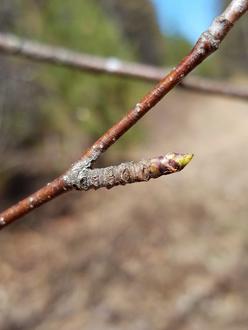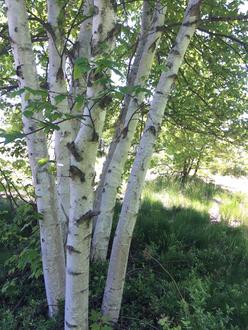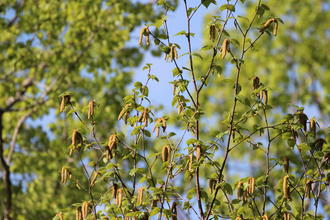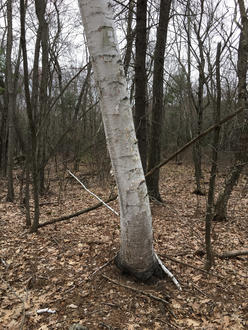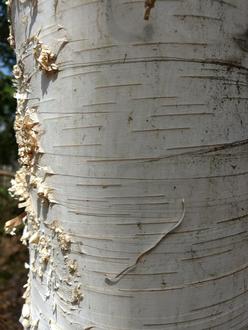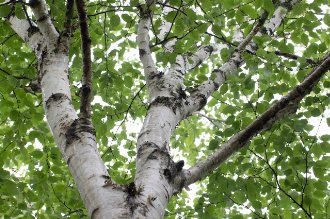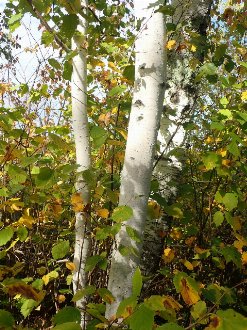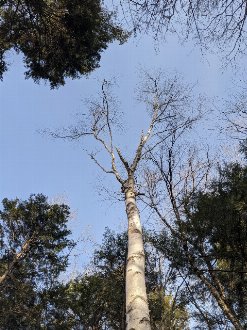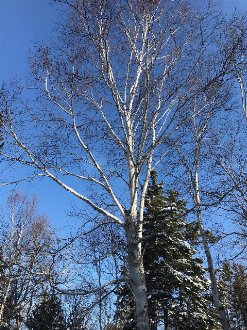Paper Birch (Betula papyrifera Marshall)
Also known as white birch.
↑Summary
A native pioneer species found in a wide range of conditions in cold, northerly parts of North America.
↑Range - Expand
| Legend | Color |
| Native or Not Present | |
| Native | |
| Native or Expanded | |
| Native or Expanded or Not Present |
This tentative map is based on our own research. It may have limited data on Canada and/or Mexico, and there is some subjectivity in our assignment of plants as introduced vs. expanded. Read more in this blog post.
Although this plant occurs somewhere in each of these regions, it may only occur in a small part of some or all of them.
In accordance with BONAP, we have marked the northern Ohio populations as non-native. Although they are probably escapes from landscaping, we marked them as "expanded" because they are near this species native range.
↑Similar Plants
↑Habitat
Found on a wide range of sites within its northerly range, primarily in early-successional stages of forests. Usually limited to sites that have experienced disturbances, including fire, clearcutting, windthrow, or avalanche. Often found in pure stands on such sites. In the north it extends to the tree line in most places, whereas its southernmost range limits are driven by temperatures: in the south of its range it becomes increasingly rarer and limited to higher elevations. In New England it is most common on cooler north-facing slopes.
Found on a wide variety of soil textures, from coarse gravels and sand through loam and to finer silt and organic muck soils. In the heart of its range, found on all topographic aspects, and from flat terrain to steep mountains and rock outcroppings. Found in a wide range of moisture conditions, from very dry sites to wet sites including margins of swamps and bogs. However, absent from highly acidic soils (pH < 5.0). In the east of its range, most abundant on drier sites and less so on wet and/or poorly-drained sites, but in the westernmost portion of its range in Alaska, it becomes more common on moister sites, and less common relative to quaking aspen (Populus tremuloides), on drier sites.
Occasionally can persist longer in forests if high-light conditions are maintained long-term by insect infestations, such as in white spruce dominated forests in eastern Quebec where spruce budworm infestations repeatedly open enough gaps for this species to persist.
↑Life Cycle
Paper birch is a fast-growing, short-lived pioneer species, but it grows tall enough to persist in the canopy in the first generation of trees on a site.
Germination occurs in spring, and is best on disturbed mineral soil with or without organic matter. Seedlings are fragile and mortality is high; surviving seedlings grow 2-5 inches in their first year. Growth rate and habit, as well as seedling survival, is heavily dependent on the presence or absence, and severity of browsing by herbivores. Saplings initially grow with a single trunk, but browsing by deer or moose often results in a multi-trunked growth habit which sometimes persists into adulthood, although such growth is less common than on gray birch. Heavy browsing kills seedlings, and rodents can kill seedlings by girdling them.
This species is highly cold-tolerant, and growth spurts can begin and continue even when minimum temperatures at night are below freezing. Diameter growth, however, only occurs in warm weather. Growth continues and increases in speed through July, and then falls off gradually; relative to other species, which tend to concentrate their growth in short spurts, this species tends to grow (both in stem/twig length and diameter) more gradually and continually throughout the growing season. Late in the season, ceasing of growth is triggered by decreasing day length.
The bark color is dark on young saplings, but becomes white when trees mature. The white color is an adaptation to growing at high latitudes, reflecting solar radiation in winter, when the sun is at a low angle, while temperatures are far below freezing. Without white bark, the sun shining directly on the bark, and also reflected off snow cover, could warm the bark dramatically, and the sharp temperature difference could cause injury.
Trees begin producing seed around 15 years of age, with production peaking between 40 and 70 years. Heavy seed production occurs roughly every other year. Flowers are wind pollinated. Seeds are released from September through November, and are distributed primarily by wind, and may blow great distances atop crusted snow.
A significant portion of seeds may not be viable. Viability is higher for seeds produced in years of peak production, and for seeds released earlier. Most seeds germinate in the spring following dispersal, but some may remain viable for a few years, forming a short-term seed bank.
Trees usually reach their maximum height by about 60-70 years, and many begin to decline shortly thereafter. Most trees live a maximum of about 140 years and many die younger, around 60-75 years, although specific timelines vary by site and in different parts of this species range. The litter from large stands of this species tends to be nutrient-rich, decomposing much faster than conifer needles; these conditions result in other, more shade-tolerant species readily establishing underneath these trees and eventually replacing them.
If trees are top-killed by fire, logging, or other disturbance, they generally resprout, but resprouts are usually not vigorous enough to fully replace a stand in the absence of seedlings. Resprouting trees are often highly attractive to deer and other browsing mammals, which limits their growth potential. In the absence of damage to the top of a tree, mature trees also send out new shoots from the base in response to removal of other nearby trees. Resprouts tend to grow faster, but be shorter-lived than trees grown uninterrupted from seedlings. Paper birch is also capable of vegetative reproduction by layering, when a formerly above-ground stem grows roots if it becomes buried with soil while still connected to a healthy plant, but such reproduction occurs uncommonly in the wild.
↑Faunal Associations
The foliage of young trees are browsed by mammals, including moose, deer, and snowshoe hare. Although it is not the most nutritious forage, its sheer abundance makes it an important food source for these species; it is often a preferred food source for snowshoe hares. Porcupines also feed on the inner bark, which is more easily accessible than that of other tree species. Beaver also eat the bark, although it is not a preferred food source.
The seeds are eaten by various birds, including chickadees, redpolls, and siskins, and small mammals, including voles and shrews. The catkins and buds are consumed by ruffed grouse.
The sap is eaten by the yellow-bellied sapsucker, which prefers this tree over most others. Hummingbirds and red squirrels also consume sap coming out of holes bored by this woodpecker.
Young stands of this species, with their tense growth, are an important source of cover for moose and deer. Mature and declining trees are an important source of nesting sites for cavity nesting birds, including woodpeckers, chickadees, nuthatches, and tree swallows.
The bronze birch borer (Agrilus anxius) eats the wood of this species, and is the only insect to cause significant damage to trees, and it frequently contributes to the death of trees that are stressed or near the end of their lifespans. Numerous insects eat the foliage, but rarely cause any harm to trees.
The forest tent caterpillar moth (Malacosoma disstria), the moth Coleophora serratella, the saddled prominent moth (Heterocampa guttivitta), the gypsy moth (Lymantria dispar), and the argent and sable moth (Rheumaptera hastata) eat this species along with many other hardwoods. Several insects eat this and other birches, including the birch skeletonizer (Bucculatrix canadensisella), the birch leafminer (Fenusa pusilla), two species of birch leaf-mining sawflies (Heterarthrus nemoratus) and the amber-marked birch leaf miner (Profenusa thomsoni) which is native to Europe and uncommon there but has been introduced to North America and become more abundant here. The cambium miner Phytobia pruinosa also eats this species, and the birch ambrosia beetle (Trypodendron betulae) and the bark beetle Xyloterinus politus both eat the bark.
↑Uses
This species is an important and sustainable source of timber, as it grows rapidly, can grow on a wide variety of sites, and tends to occur in pure stands which facilitates harvest. The wood is widely available and inexpensive. The wood has a moderate density, and is usually easy to work with, but has low resistance to rot and insect damage. It is used primarily to make plywood and veneer, and also used for boxes and crates, turned objects, and small specialty wood objects.
Sometimes planted as a landscaping plant, including considerably farther south than its native range, due to the striking visual appearance of its white bark. Often fares poorly in these areas, due to its lower tolerance of hot, humid summer conditions. The river birch (Betula nigra) has similar-looking bark and is usually a better choice in warmer climates, and gray birch (Betula populifolia) is also a good choice as it is somewhat more heat-tolerant and also has a small maximum size.
The sap has historically been used to make a syrup, much like that of sugar maple (Acer saccharum), and has also been used to produce wine and beer. However, such usage has declined and only a few such commercial operations still exist.
This species has also been used to reclaim acid mine spoils. Although seedlings typically do not establish on soil with pH less than 4.0, slightly larger plants can be planted and survive on soils with pH between 3.0 and 4.0, and over time the litter from this tree can be effective at increasing the pH and restoring the soil.
↑Notes
Although it frequently establishes on burned sites, paper birch creates conditions around it that prevent fire. The crown of paper birch has a high moisture content, and the open nature of paper birch stands tend to create lush undergrowth of shrubs and herbaceous plants which also have high moisture content. However, the trees and vegetation tend to create warmer, drier soil conditions.
Paper birch stands thus tend to exclude high-intensity crown fires, either excluding fire completely, or leading to fire only entering a stand as a slow-moving, low-intensity ground fire, contrasting with conifer stands which are more likely to experience severe crown fires.
Paper birch is thus a key component of a cycle in many forests, in which it colonizes burned sites, excludes fire until conifers are able to establish, and then eventually a more severe fire creates conditions for birch to recolonize.
↑Links & External Resources
• Paper Birch | The Wood Database (About This Site)
• Paper Birch | Fire Effects Information System (FEIS) (About This Site)
• Betula papyrifera (Paper Birch) | Illinois Wildflowers (About This Site)
• Betula papyrifera (Paper Birch) | USDA PLANTS Database (About This Site)
• Betula papyrifera | Go Botany (About This Site)
• Betula papyrifera (Paper Birch) | Missouri Botanical Garden Plant Finder (About This Site)
• Paper Birch | Virginia Tech Dendrology Factsheets (About This Site)
• Paper Birch | Silvics of North America (About This Site)
• Betula papyrifera | Biota of North America Project (BONAP) (About This Site)
• Betula papyrifera | NatureServe Explorer (About This Site)
• Betula papyrifera | Flora of North America (About This Site)
• Betula papyrifera Marshall (Paper Birch) | Digital Atlas of the Virginia Flora (About This Site)



